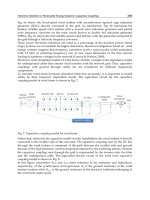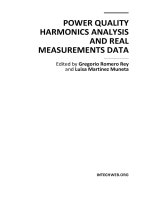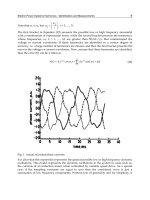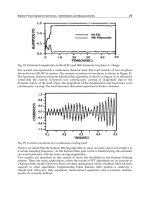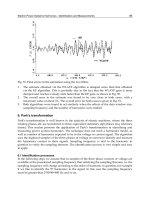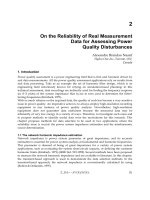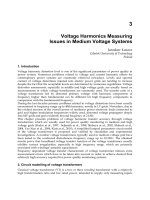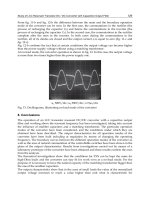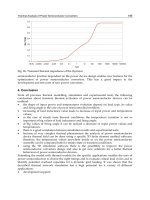Power Quality Harmonics Analysis and Real Measurements Data Part 11 pptx
Bạn đang xem bản rút gọn của tài liệu. Xem và tải ngay bản đầy đủ của tài liệu tại đây (480.09 KB, 20 trang )
Characterization of Harmonic Resonances in
the Presence of the Steinmetz Circuit in Power Systems
189
• The resonant behavior of the Steinmetz circuit with power system reactors occurs in a
range of relatively large harmonics.
• The resonances are located in the low-order harmonics only if the displacement power
factor of the single-phase load impedance is close to the unity value (i.e.,
λ
L
≈ 1) and this
impedance is small in comparison with the supply system reactances (i.e., small r
L
ratios). The former condition is common but, considering that r
L
=
λ
L
·S
S
/S
L
(Sainz et al.,
2009a), the latter only occurs in weak power systems where the short-circuit power at
the PCC bus, S
S
, is low compared to the apparent power of the single-phase load, S
L
.
•
The resonances are shifted to high-order harmonics if the
τ
1
ratio of the Steinmetz
circuit inductor is far from the zero value, i.e. its displacement power factor
λ
1
is far
from the unity value. It is also true if the Steinmetz circuit capacitor degrades, i.e. the
Steinmetz circuit suffers capacitor loss and d
C
is also far from the unity value.
6. Examples
For the sake of illustration, two different implementations of the k
r, a
expression, (22), are
developed. In the first, the analytical study in Section 4 is validated from laboratory
measurements. Several experimental tests were made to check the usefulness of the k
r, a
expression in locating the parallel and series resonance. In the second, this expression is
applied to locate the harmonic resonance of several power systems with a Steinmetz circuit
in the literature.
6.1 Experimental measurements of power system harmonic response
To validate the analytical study, measurements were made in two downscaled laboratory
systems corresponding to the networks of Fig. 4 (parallel resonance) and Fig. 6 (series
resonance). The frequency response measurements were made with a 4.5 kVA AC ELGAR
Smartwave Switching Amplifier as the power source, which can generate sinusoidal
waveforms of arbitrary frequencies (between 40 Hz and 5000 Hz) and a YOKOGAWA
DL 708 E digital scope as the measurement device. From the results shown in the next
Sections, it must be noted that (22) provides acceptable results. Although experimental tests
considering the inductor resistance (R
1
≈ 0.1342 pu) are not shown, they provide similar
results.
6.1.1 Experimental measurements of the parallel resonance
The harmonic response of the network in Fig. 4 was measured in the laboratory for two
cases with the following system data (U
B
= 100 V and S
B
= 500 VA):
•
Case 1 (studied in Section 3.1):
-
Supply system: Z
S1
= 0.022 +j0.049 pu.
- Railroad substation: R
L
= 1.341 pu, λ
L
= 1.0.
-
External balancing equipment: X
1, apx
= 2.323 pu and X
2, apx
= 2.323 pu [neglecting
the inductor resistance, (1)] and d
C
= 1.0, 0.75, 0.5 and 0.25.
•
Case 2: System data of Case 1 except the single-phase load fundamental displacement
factor of the railroad substation, which becomes
λ
L
= 0.95. The Steinmetz circuit
reactances also change, i.e. X
1, apx
= 1.640 pu and X
2, apx
= 5.975 pu (1).
Fig. 11a compares the parallel resonance measured in the experimental tests with those
obtained from (22). In order to analytically characterize the resonance, the variable values
Power Quality Harmonics Analysis and Real Measurements Data
190
corresponding to the above data are r
L
= 27.4, λ
L
= 1 and 0.95 (Cases 1 and 2, respectively)
and
τ
1
= 0.
6.1.2 Experimental measurements of the series resonance
The harmonic response of the network in Fig. 6 was measured in the laboratory for two
cases with the following system data (U
B
= 100 V and S
B
= 500 VA):
•
Case 1:
-
Supply system: Z
S1
= 0.076 +j0.154 pu.
- Railroad substation: R
L
= 1.464 pu, λ
L
= 1.0.
-
External balancing equipment: X
1, apr
= 2.536 pu and X
2, apr
= 2.536 pu [neglecting
the inductor resistance, (1)] and d
C
= 1.0, 0.75, 0.5 and 0.25.
-
Three-phase load: Grounded wye series R-L impedances with |Z
P1
| = 30.788 pu
and λ
P
= 0.95 are connected, i.e. the three-phase load model LM1 in (Task force on
Harmonic Modeling and Simulation, 2003).
•
Case 2 (studied in Section 3.2): System data of Case 1 except the single-phase load
fundamental displacement factor of the railroad substation, which becomes
λ
L
= 0.95. The
Steinmetz circuit reactances also change, i.e. X
1, apr
= 1.790 pu and X
2, apr
= 6.523 pu (1).
Fig. 11b compares the series resonance measured in the experimental tests with those
obtained from (22). In order to analytically characterize the resonance, the variable values
corresponding to these data are r
L
= 9.51, λ
L
= 1 and 0.95 (Cases 1 and 2, respectively) and
τ
1
= 0.
10
0
|
k
p
, meas
−
k
r
, a
|/
k
p
, meas
(%)
2
4
6
8
(a)
Case 1
Case 2
k
r, a
k
p, meas
k
r, a
0.3
d
C
0.4 0.5 0.6 10.7 0.8 0.9
(b)
0.3
d
C
0.4 0.5 0.6 10.7 0.8 0.9
Case 1
Case 2
k
r, a
k
s, meas
k
r, a
18
10
4
14
6
8
12
16
k
p
, meas
,
k
r
, a
11
5
2
7
3
4
6
8
9
10
k
s
, meas
,
k
r
, a
5
0
1
2
3
4
|
k
s
, meas
−
k
r
, a
|/
k
s
, meas
(%)
Fig. 11. Comparison between k
res
and k
r, a
. a) k
res
= k
p, meas
. b) k
res
= k
s, meas
.
6.2 Harmonic resonance location in several power systems
This section briefly describes several works in the literature on the Steinmetz circuit in
power systems, and determines the harmonic of the resonance produced by the presence of
this circuit from (22). This allows interpreting the results in the works and predicting the
harmonic behavior of the studied power systems.
In (ABB Power Transmission, n.d.), an extensive railway network for coal haulage in East
Central Queensland is presented and the installation of nine SVCs in the 132 kV grid to
Characterization of Harmonic Resonances in
the Presence of the Steinmetz Circuit in Power Systems
191
achieve dynamic load balancing is analyzed. The traction load is supplied from single-phase
132/50 kV transformers at each supply substation providing a 25 kV catenary voltage from
50/25 kV autotransformers at intervals along the track. The short-circuit power S
S
at 132 kV
bus is below 300 MVA while traction loads may reach short duration peaks of S
L
= 20 to
40 MVA. A total of 28 single-phase harmonic filters for 50 kV tuned to the 3
rd
, 5
th
and 7
th
harmonics were installed in the substations to prevent harmonics generated in the
locomotive thyristor drives from being injected into the 132 kV power system. The harmonic
impact of the Steinmetz circuit installation on this traction system can be examined from
(22). Considering
τ
1
= 0, d
C
= 1 and the displacement power factor
λ
L
of the traction load
close to the unity value, the ratio r
L
= R
L
/X
S
=
λ
L
·S
S
/S
L
is between 15 to 7.5 (S
L
= 20 to 40,
respectively) and the resonance is located at the harmonics k
r, a
= 3.7 to 2.68. It is interesting
to note that the Steinmetz circuit connection could cause parallel and series resonances close
to the 3
rd
harmonic, damaging harmonic power quality. If the displacement power factor
was below unity value (e.g.,
λ
L
= 0.95), the resonance would shift to k
r, a
= 5.93 to 4.36
(S
L
= 20 to 40, respectively) worsening the harmonic problem. In conclusion, it is not
advisable to use the Steinmetz circuit to balance the traction load currents consumed in this
installation. However, since the short-circuit power can be below 300 MVA and the
transformer short-circuit impedances are not considered in the study, the ratio r
L
values can
be lower than the previous ones and the resonance can be below the 3
rd
harmonic (see
Fig. 10) avoiding harmonic problems.
In (Barnes & Wong, 1991), an unbalance and harmonic study carried out for the Channel
Tunnel 25 kV railway system supplied from the UK and French 400/225/132 kV grid
systems is presented. On the UK side, the PCC between the traction load and the tunnel
auxiliary load is at the Folkestone 132 kV busbar with a minimum short-circuit power
S
S
equal to 800 MVA. On the French side, the PCC between the traction load, the auxiliary
load and other consumers is at the Mandarins 400 kV busbar with a minimum short-circuit
power S
S
equal to 11700 MVA. The traction loads range from S
L
= 0 to 75 MVA with a
displacement power factor
λ
L
= 0.93. Steinmetz circuit is located on the UK side with fast-
acting thyristor-controlled reactors and capacitors, which enable the balancing equipment
output to vary with the load pattern. Moreover, harmonic studies based on the harmonic
spectrum measured in the catenaries of the British Rail network and provided by
continental locomotive manufacturers were conducted to analyze the harmonic filter
installation. They revealed that the harmonic limits on the French side are within
specification limits and no filters are required while, on the UK side, these limits are
exceeded and harmonic filters must be installed to reduce harmonic distortion to acceptable
levels. These studies can be complemented with harmonic resonance location in the
Steinmetz circuit. Thus, considering
τ
1
= 0, d
C
= 1 and the maximum traction load (i.e.,
S
L
= 75 MVA), the ratio r
L
= R
L
/X
S
=
λ
L
·S
S
/S
L
is 145.08 and 9.92 and the resonance is located
at harmonics k
r, a
= 21.6 and 6.0 on the French and UK side, respectively. This resonance is
shifted to higher harmonics if the traction load is lower. The auxiliary loads and other
consumers are not considered in the location of the resonances because their impedance is
large enough (i.e., z
P
> 20).
In (Arendse & Atkinson-Hope, 2010), the design of the Steinmetz circuit in unbalanced and
distorted power supplies is studied from a downscaled laboratory system such as that in
Fig. 3. The system data are Z
S1
= 0.0087 +j0.00079 Ω, R
L
= 4.84 Ω, λ
L
= 1.0,
τ
1
= 0, d
C
= 1.0 and
a three-phase Variable Speed Drive (VSD) of 24 kVA rated power is used as a harmonic
Power Quality Harmonics Analysis and Real Measurements Data
192
source. A three-phase linear load with |Z
P1
| = 9.802 Ω and λ
P
= 0.81 (load model LM1) is
also connected. The study shows that there is no harmonic problem in the system and that
voltage distortion is below 0.05% [Table 7 in (Arendse & Atkinson-Hope, 2010)]. This can be
analyzed from (22) because, considering that r
L
= 4.84/0.00079 = 6127 and
z
P
= 9.802/0.00079 = 12408 (i.e., the three-phase linear load influence is negligible), the
parallel resonance “observed” from the VSD is located at k
r, a
= 72.9.
7. Conclusion
In this chapter, the analytical study conducted in previous works on the parallel and series
resonance in power systems with a Steinmetz circuit is unified and an expression unique to
the location of both resonances is provided, which substantially improves those proposed in
earlier works on the parallel resonance. This expression considers not only the impact of
capacitor degradation on the resonance but also the resistance of the Steinmetz circuit
inductor, which is another contribution to previous studies.
The sensitivity analysis reveals that the resonances mainly depend on the power system
inductors and the single-phase load of the Steinmetz circuit. However, capacitor bank
degradation and the R/X ratio of the Steinmetz circuit inductor can also strongly influence
the resonance. Broadly speaking, Steinmtez circuit resonances with power system reactors
appear at high-order harmonics. They only occur at low-order harmonics if the single-phase
load impedance is small in comparison with the supply system reactance (i.e., in weak
power systems) and the single-phase load power displacement factor is close to the unity
value. The study also shows that the capacitor bank degradation and the resistance of the
Steinmetz circuit inductor shift the resonance to higher harmonics. The analytical study
results are validated with experimental measurements in a downscaled laboratory system
and the study is applied to analyze several power systems with a Steinmetz circuit in the
literature. Measurements in actual ac traction systems will be necessary to fully confirm
these results.
Future research should focus on the power system harmonic response “observed” from the
railroad substation. The framework developed in the previous research and completed in
this Chapter must make it possible to obtain analytical expressions to locate resonances from
the substation.
8. Acknowledgment
This work is supported by grant DPI2010-15448.
9. References
ABB Power Transmission (n.d.). Multiple SVC installations for traction load balancing in
Central Queensland. In: Pamphlet A02-0134, 26/02/2011, Available from
<
Arendse, C. & Atkinson-Hope, G. (2010). Design of a Steinmetz symmetrizer and application
in unbalanced network. Proceedings of the 45
th
International Universities Power
Engineering Conference (UPEC), pp. 1-6, 2010.
Characterization of Harmonic Resonances in
the Presence of the Steinmetz Circuit in Power Systems
193
Barnes, R. & Wong, K. T. (1991). Unbalance and harmonic studies for the Channel Tunnel
railway system. IEE Proceedings B, Electric Power Applications, Vol. 138, No. 2, 1991,
pp. 41-50.
Capasso, A. (1998). The power quality concern in railway electrification studies. Proceedings
of 8
th
IEEE Int. Conf. on Harmonics and Quality of Power (ICHQP), pp. 647-652, 1998.
Caro, M., Sainz, L. & Pedra, J. (2006). Study of the power system harmonic response in the
presence of the Steinmetz circuit. Electric Power Systems Research, Vol. 76, No. 12,
August 2006, pp. 1055-1063.
Chen, T-H. (1994). Criteria to estimate the voltage unbalances due to high-speed railway
demands. IEEE Transactions on Power Systems, Vol. 9, No. 3, August 1994, pp. 1672-
1678.
Chen, T-H. & Kuo, H-Y. (1995). Analysis on the voltage unbalance due to high-speed
railway demands. Proceedings of the International Conference on Energy Managment
and Power Delivery, pp. 657-661, 1995.
Chicco, G., Chindris, M., Cziker, A., Postolache, P. & Toader, C. (2009). Analysis of the
Steinmetz compensation circuit with distorted waveforms through symmetrical
component-based indicators. Proceedings of the IEEE Bucharest Power Tech Conference
2009, pp. 1-6, 2009.
Chindris, M., Cziker, A., Stefanescu, A. S. & Sainz, L. (2002). Fuzzy logic controller for
Steinmetz circuitry with variable reactive elements. Proceedings of 8
th
International
Conference OPTIM 2002, Proc. 1G.3, pp. 233-238, 2002.
Czarnecki, L. S. (1989). Reactive and unbalanced currents compensation in three-phase
asymmetrical circuits under non-sinusoidal conditions. IEEE Transactions on
Instrumentation and measurement, June 1989, Vol. 38, No. 3, pp. 754-759.
Czarnecki, L. S. (1992). Minimization of unbalanced and reactive currents in three-phase
asymmetrical circuits with non-sinusoidal voltage. Proceedings IEE, Vol. 139, Pt. B.,
No. 4, July 1992, pp. 347-354.
Hill, R. J. (1994). Electric railway traction. Part3: Traction power supplies. Power Engineering
Journal, Vol. 8, No. 6, 1994, pp. 275-286.
Howroyd, D. C. (1989). Public supply disturbances from AC traction. Proceedings of the
International Conference on Main Line Railway Electrification, pp. 260-264, 1989.
IEC 61000-3-6, Part 3-6: Limits – Assessment of emission limits for the connection of
distorting installations to MV, HV and EHV power systems, 2008-02.
Jordi, O., Sainz, L. & Chindris, M. (2002). Steinmetz system design under unbalanced
conditions. European Transactions on Electrical Power, Vol. 12, No. 4, July/August
2002, pp. 283-290.
Lee, S.Y. & Wu, C.J. (1993). On-line reactive power compensation schemes for unbalanced
three-phase four wire distribution feeders. IEEE Transactions on Power Delivery,
Vol. 8, No. 4, October 1993, pp. 1958-1965.
Marczewski, J. J. (1999). IEEE working group on system and equipment considerations for
traction. Utility interconnection issues. Proceedings of IEEE Power Engineering Society
Summer Meeting, Vol. 1, pp. 439-444, 1999.
Mayer, D. Kropik, P. (2005). New approach to symmetrization of three-phase networks.
Journal of Electrical Engineering, 2005, Vol. 56, No. 5-6, pp. 156-161.
Power Quality Harmonics Analysis and Real Measurements Data
194
Qingzhu, W., Mingli, W., Jianye, C. & Guipping, Z. (2010). Optimal balancing of large
single-phase traction load. Proceedings of the IET Conference on Railway Traction
Systems (RTS 2010), pp. 1-6, 2010.
Qingzhu, W., Mingli, W., Jianye, C. & Guipping, Z. (2010). Model for optimal balancing
single-phase traction load based on the Steinmetz’s method. Proceedings of the IEEE
Energy Conversion Congress an Exposition (ECCE), pp. 1565-1569, 2010.
Sainz, L., Caro, M. & Pedra, J. (2004). Study of electric system harmonic response. IEEE
Transactions on Power Delivery, Vol. 19, No. 2, April 2004, pp. 868-874.
Sainz, L., Pedra, J. & Caro, M. (2005). Steinmetz circuit influence on the electric system
harmonic response. IEEE Transactions on Power Delivery, Vol. 20, No. 2, April 2005,
pp. 1143-1156.
Sainz, L., Pedra, J. & Caro, M. (2007). Influence of the Steinmetz circuit capacitor failure on
the electric system harmonic response. IEEE Transactions on Power Delivery, Vol. 22,
No. 2, April 2007, pp. 960-967.
Sainz, L., Pedra, J. & Caro, M. (2009). Background voltage distortion influence on the power
electric systems in the presence of the Steinmetz circuit. Electric Power Systems
Research, Vol. 79, No. 1, January 2009, pp. 161-169.
Sainz, L., Caro, M. & Caro, E. (2009). Analytical study on the series resonance in power
systems with the Steinmetz circuit. IEEE Transactions on Power Delivery, Vol. 24, No.
4, October 2009, pp. 2090-2098.
Sainz, L., Caro, M., Caro, E. (in press). Influence of Steinmetz Circuit Capacitor Degradation
on Series Resonance of Networks. European Transactions on Electrical Power, in press
(DOI: 10.1002/etep.514).
Sainz, L. & Riera, S. (submitted for publication). Study of the Steinmetz circuit design. Power
Systems Research.
Task Force on Harmonics Modeling and Simulations. Modeling and simulation of the
propagation of harmonics in electric power networks. Part I: Concepts, models and
simulation techniques. IEEE Transactions on Power Delivery, Vol. 11, No. 1, January
1996, pp. 452–465.
Task Force on Harmonic Modeling and Simulation. Impact of aggregate linear load
modeling on harmonic analysis: A comparison of common practice and analytical
models. IEEE Transactions on Power Delivery, Vol. 18, No. 2, April 2003, pp. 625-630.
8
Stochastic Analysis of the Effect of Using
Harmonic Generators in Power Systems
Mohsen Abbas Pour Seyyedi and Amir Hossein Jahanikia
Mefragh Company
Iran
1. Introduction
Switch mode electronic devices including Compact Fluorescent Lamp (CFL) and personal
computers introduce capacitive power factor and current harmonics to the power system.
Since middle 80’s and with the expanding use of nonlinear switch mode electronic loads,
concerns arose about their effect on the power systems. In many IEEE documents, it is
recommended to study the effect of electronic loads. Switch mode devices have a capacitive
power factor between 55 and 93 percent (Allexperts), which can cause the increase of
reactive power and power loss. The power loss in an office building wirings due to the
current harmonics may be more than twice that of the linear load equipment (Key et al.,
1996). Capacity of the transformers may be reduced more than 50 per cent in the presence of
harmonic components (Schneider, 2009).
CFL is a more efficient and durable replacement of the traditional incandescent lamp.
Replacing traditional light bulbs by CFLs has several advantages including energy saving,
increase in the capacity of plants and distribution transformers, peak shaving, less carbon
emission and customer costs. On average, 20 percent of the total use of electricity is
consumed in lighting (Michalik et al., 1997), (Tavanir). However, the increase in the number
of electronic devices especially the CFLs in power systems must be carefully planned.
Replacing the incandescent light bulbs with CFLs means replacing the system’s major
Ohmic load with a capacitive load of high frequency harmonic components. In areas where
lighting is a major use of electricity, e.g. places where natural gas or other fossil fuels are
used for heating purposes, unplanned replacing of incandescent lamps with CFLs can
introduce unexpected negative effects on the system. Also, in areas with a considerable
number of other switch mode devices e.g. commercial areas with many office buildings it is
important to plan the number of CFLs carefully. Most of the present studies on the effect of
switch mode devices are based on tentative experiments and power factor measuring before
and after using the devices in the power system (Gonos et al., 1999), and proposing a model
for the network has been less discovered.
In order for studying such effects, it is better to classify the system equipment to the
substation equipment and consumer side equipment. Dramatic changes in power quality
indicators of the distribution systems may cause disorders or even damages in the consumer
equipments. Such disorders are especially important for sensitive appliances such as
medical and hospital devices.
Power Quality Harmonics Analysis and Real Measurements Data
196
In this chapter we review our novel approach for studying the effect of switch mode devices
and present a novel stochastic modelling approach for analysing the behaviour of the power
system in the presence of switch mode devices. We also study the major KPI of the power
system and study how these KPI will be affected by adding the current harmonics. Section 2
presents how we obtain an accurate model for CFL based on circuit simulation. This section
also defines a general circuit model for the harmonic generating devices. Section 3 presents
our novel approach for stochastic modelling of the power system behaviour. In section 4 we
summarize the major power system KPI on both substation and consumer sides. We also
discuss how the switch mode devices may affect the devices on each side. Section 5 presents
our approach for simulating the power system behaviour. Conclusion and discussion are
presented in section 6.
2. Modelling of switch mode devices
This section studies the general specifications of switch mode devices. We simulate a CFL
ballast circuit in SPICE software. We also present the device model for a personal computer.
Based on these models, we develop a general circuit model to simulate the behaviour of all
switch mode capacitive devices. Without circuit simulation, it is not possible to provide an
accurate model representation in the power system. In contrast with the models that are
based on measuring and estimating the device characteristic, this approach gives much
more accurate results. The accuracy of this approach can be chosen at the desired level.
2.1 Simulation of CFL ballast circuit in SPICE
The common 220V power system voltage is not enough to start the fluorescent lamps.
Therefore, CFLs include a ballast circuit for providing the starting high voltage. In
traditional fluorescent lamps, inductive ballasts are widely utilized. However, electronic
ballasts which are used in CFLs have much better quality (Aiello et al., 2008). Electronic
ballasts are composed of a rectifier and a DC-AC converter. Fig. 1 shows the general block
diagram of a ballast circuit.
Fig. 1. Block diagram of a CFL ballast circuit. Figure courtesy of (Sasaki, 1994).
Several circuits are simulated in SPICE software for this project. Fig. 2 shows one sample
CFL ballast circuit model in SPICE. This circuit is similar to that of (Sasaki, 1994) with slight
changes. The input full wave rectifier and the large input capacitor make the current have
narrow high peaks at short intervals and almost zero value elsewhere. Fig. 3 shows the
output voltage and current of the circuit in Fig. 2.
Frequency analysis shows that the CFL current is made up of odd harmonic components of
the main frequency (50 or 60 Hz). The CFL is modelled by a number of current sources with
Stochastic Analysis of the Effect of Using Harmonic Generators in Power Systems
197
the proper harmonic values. Equation 1 shows the mathematical model for a CFL when the
voltage is assumed to be a cosine function.
4
21 21 21 21
00
cos 2
cos2 (2 1) cos2 (2 1)
CFL
CFL n n n n
nn
vV ft
i I nft I nft
(1)
The more the number of harmonics is, the more accurate the model will be. In this study we
use the first five odd harmonics (1, 3, 5, 7, and 9). A schematic of the model is shown in Fig.
4. The power factor of this circuit is 93%. In order for having a flexible model for different
market suppliers, the power factor is chosen flexible in the simulation experiments.
Fig. 2. Simulation of a sample ballast circuit in SPICE.
Fig. 3. Sinusoidal voltage and resulting current waveshape for a sample CFL ballast circuit.
Power Quality Harmonics Analysis and Real Measurements Data
198
Fig. 4. Circuit model of a switch mode device.
The values of the current and phase in equation 1 are summarized in Table 1 for the circuit
in Fig. 2.
Current Harmonic First Third Fifth Seventh Ninth
Peak I
2n+1
(A)
0.2 0.182 0.162 0.138 0.112
Phase Φ
2n+1
(Rad)
0.260 3.499 0.609 4.000 0.799
Table 1. Peak value and phase of the current harmonics for the sample CFL of Fig. 2.
We name the overall current phase lag as central phase lag
Φ
c
.
2.2 Circuit model for other electronic devices
Personal computers and other electronic equipment such as printers, etc. generate current
harmonics in the power system too, because they all include a rectifier. The harmonic
components of personal computers are calculated and provided in the literature (Key et al.,
1996). Fig. 5 shows the relative value of these components. Therefore, we can use a similar
model to that of Fig. 4 for modelling such electronic devices.
Fig. 5. Relative values of the current harmonics for a personal computer.
3. Stochastic modelling of switch mode devices in power system
Phase of a harmonic generating device is not a constant value. But it is a random variable
that varies in a specific range that can be provided by the manufacturer. Therefore, the
model in equation 1 will be modified to that of equation 2.
Stochastic Analysis of the Effect of Using Harmonic Generators in Power Systems
199
4
21 21
0
cos 2 (2 1) (2 1)
mn n m
n
iI nft n
(2)
In this model, m is the device number in the network. In practice, the total number of
devices M is a large number. For each device we have a phase shift ΔΦ
m
from the central
phase. Distribution of ΔΦ
m
can be assumed to be uniform or Gaussian depending on the
manufacturer’s datasheet. In other words for the uniform distribution:
max max
max
1
, ( )
2
cmc m
P
(3)
In the above equation, Φ
max
is the maximum phase shift from the theoretical phase lag Φ
c
. If
the probability distribution is Gaussian, ΔΦ
m
is obtained from equation 4:
2
2
/2
2
1
()
2
m
Pe
(4)
Where φ and σ are the mean and variance of the phase lag. The current value for a large
number M of CFLs with the above specifications is equal to i in equation 3:
4
21 21
00
0
cos 2 (2 1) (2 1)
MM
nnm
m
mm
n
ii I nft n
(5)
Finding the probability density function, expectation and variance of current in the above
equation is complicated (if possible!). Instead, we rely on numerical simulation to find the
pdf of power system current. In a sample experiment, our power system is composed of a
thousand CFLs. The average phase lag of these CFLs is fifteen degrees and has a uniform
distribution of range 15±10 degrees. We use a Parzen window (Duda et al., 2007) approach
to find the pdf of the peak output current. Fig. 6 shows the result. The mean value and
standard deviation of the current in this experiment are 611.5 and 2.45. We may notice that if
the variance in the phase shift is not considered, meaning that we do not assume the CFL
phase to be a random variable, the peak current will be equal to 701 Amperes. When we
dimension the network, this means at least 13% more capacity. Different results can be
obtained for different values of phase range for the electronic devices.
Fig. 6. Relative values of the current harmonics for a personal computer.
Power Quality Harmonics Analysis and Real Measurements Data
200
4. Effect of switch mode devices in power system
The main devices in any power systems include thermal loads, electronic devices and
inductive loads. Thermal loads, including the traditional lighting, can be modelled as a
simple resistance. In regions where a considerable part of heating is based on electricity,
heating constitutes a large share of the thermal load. Electronic devices include television
and personal computer. The most common inductive appliances are cooling devices, which
are air conditioning systems and refrigerators. Different values of power from 150W to
2000W are used for induction motors, depending on the application type and geographical
region of use.
In this section we take a closer look to the different equipment and the effects of the
harmonics on individual devices on both distribution and consumer sides. This section
mainly focuses on theoretical study of the effects of the harmonics on the key performance
indicators rather than practical measurements. Fig. 2 shows the fundamentals of the analysis
in the rest of this section.
Fig. 7. Relation between using CFL (as a switch mode device) and the power system
equipment.
4.1 General power system KPI
The most important and most useful KPI of the power system include:
4.1.1 Total Harmonic Distortion (THD)
THD is defined as in equation 6:
2
2
1
n
n
V
THD
V
(6)
Stochastic Analysis of the Effect of Using Harmonic Generators in Power Systems
201
This factor may be calculated for voltage, current or power. Current THD is normally much
higher than the voltage THD for electronic devices and is more than 100%.
4.1.2 Crest Factor
Crest Factor is the indicator that shows the ratio of the peak value of the wave shape to its
average value in a time interval (rms)
1
, as shown in equation 7.
p
eak
rms
x
C
x
(7)
This factor is especially important for the analysis of the effect on protective and control
equipment such as relays.
4.1.3 Power Factor
Power Factor is caused by the input rectifying capacitor of the ballast circuit. The capacitive
characteristic of CFL is an advantage in systems with a high inductive load.
4.2 Power substation equipment
This section studies the effect electronic devices on the substation equipments, which
provide the low voltage power to the end users and can be classified to the following
categories:
4.2.1 Transformers
Transformers are used in the distribution system in order to change the levels of voltage and
current in the low voltage scales. These may also include the power and instrumentation
transformers and Auto-Boosters. In transformers, both the core and the wires are sensitive to
the change of the power KPI. The harmonics have the following different effects on
transformers.
Transformer loss, which is obtained as in equation 8:
TNLL
PPP
(8)
In equation 8, P
N
is the “no-load” loss and P
LL
is the “full-load” loss. The no-load loss
depends on the voltage and core material. The full load loss is defined as in equation 9:
LL DC EC OSL
PPPP (9)
In equation 9, P
DC
is the DC resistance loss, P
EC
is the eddy current loss and P
OSL
is the stray
loss. Eddy current, which is proportional to the square of frequency, is caused by skin effect
and proximity effect. Therefore, the current harmonics increase the eddy current loss
dramatically. This increase results in the increase in temperature and hence reducing the
transformer lifetime (Ashok).
Lifetime of a transformer depends on the functioning situations such as loading percentage
and functioning temperature. Current harmonic components can increase the RMS value of
1
Root Mean Square
Power Quality Harmonics Analysis and Real Measurements Data
202
the current and consequently the resistive power loss. The heat also remains in the
surrounding air and affects the transformer lifetime. In the delta-wye connections in the
transformers, the harmonic components of current start rotating in the wye side and cause
heat generation and reduce transformer capacity. This occurs for the 3rd, 9th and 15th
harmonic components. The current harmonics also cause saturation of the transformer.
In order to control the effect of current harmonics on transformers and electromotors, it is
recommended not to have a current harmonic component more than 5% of the transformer’s
nominal current in the ANSI/IEEE C57.12.00-2000 and IEC60076 standards (Sadati et al.,
2008). The K-Factor, which is defined in equation 10, identifies the relation between
transformer design and increase in the electronic devices.
Fig. 8. Comparing different losses in the transformer core.
22
1
()
h
h
KFactor I
p
hh
(10)
In equation 10, h is the harmonic order and I
h
is its current component in per unit. The
definition of K-Factor may be different in different standards. For example, in BS7821
standard it is defined as in equation 11.
0.5
2
2
1
2
1
1
1
q
n
n
eI I
KFactor n
eI I
(11)
4.2.2 Transmission systems
Transmission systems include power cables and wires. Transmitters are the conductors
which are used in power system. Because of the skin effect (Hightech), the resistance of
conductors increases with the increase of frequency. Because of the small high frequency
components of the electronic devices, using these devices has a small effect on the
conductors. Simulations show that the current amplitude for a sample CFL in frequencies
between 1000 and 1500 Hertz (harmonics 20th to 30th) is less than 1% of the nominal value.
Therefore, capacity reduction of cables and wires will be between 1% and 6% of conductor
capacity in the worst case (100% replacement) (Vapopoulos, 1964).
Stochastic Analysis of the Effect of Using Harmonic Generators in Power Systems
203
4.2.3 Electronic devices:
Electronic devices including the automation or control devices and the equipments that are
used for stabilizing the power systems such as PLC transmitters and RTU equipment. As the
electronic devices are used for transmitting and receiving data, high frequency current can
cause disorders in their functioning, such as increased noise level in communication
systems. Such devices are usually installed close to power system equipment such as
transformers.
4.2.4 Control and protection systems
Control and protection system, such as fuses, relays and circuit breakers, which control or
guard the power systems. Current harmonics in the system may cause pre-heating in the
fuse and problems in its function. Fuses may also be affected by the skin effect and the
resulting heat may cause their malfunctioning. In circuit breakers, which work based on
di/dt, current harmonics may cause unexpected faults. Here, the peak factor is important as
well. The solenoids may also be damaged because of the harmonics. Delay in solenoid’s
functioning may cause sparks and damage. Vacuum circuit breakers are less sensitive to the
harmonics. For relays, changes in the zero point may case improper functioning. These
effects must be identified via practical experiments. Some manufacturers have presented
“harmonic adaptive” models (Ashok).
4.3 Equipment on the consumer side
The consumer side equipments are classified into three different categories (Gowan, 2006):
4.3.1 Electric machines
Electric machines which are inductive devices and as confirmed by simulation using them
together with electronic devices can improve the power quality indicators. The n
th
current
component of an electric machine is obtained as in equation 12:
n
n
n
V
I
n
f
L
(12)
In equation 12, V
n
is the n
th
voltage harmonic and L
n
is the inductance in n
th
harmonic
(Markiewicz et al., 2004). L
n
increases because of the skin effect. Power loss of electric
motors is obtained from equation 13:
2
1.5 2
1
n
hnr
V
PPkP
nV
(13)
where
(1 )(1 )
s
r
rr
T
E
k
T
SE
. T
s
is the torque, E
r
is efficiency and S
r
is the slippage (Schneider
2010).
The heat generated by the harmonics may cause decreasing the motor lifetime. In addition,
the eddy currents can generate heat in the motors, similar to the transformers. The heat
generation is almost the same in synchronous and asynchronous motors. In the case when
all incandescent lamps are replaced by CFLs, the performance of induction motors will be
between 5 and 15 percent (Vapopoulos, 1964). For the asynchronous motors, IEC60892
standard is defined as in equation 14:
Power Quality Harmonics Analysis and Real Measurements Data
204
13
2
2
0.02
h
h
U
HVF
h
(14)
U
h
is the harmonic voltage of order h.
4.3.2 Measurement devices
Measurement devices: such as electricity meters, current transformers, voltage transformers
and electronic instrumentation. The measurement transformer error is calculated as:
fp
KCVK
(15)
where C is the ratio of real ratio to actual ratio (for current transformers), V is the ratio of
real ratio to actual ratio (for voltage transformers) and K
p
is angle correction coefficient
(Hightech). The same as in power station transformers, high frequency current harmonics
result in early saturation of transformer core and error in measurement. Electronic devices
which work based on the zero crossing may also be affected by wave shape distortion.
Errors may occur while calculating voltage and current rms values. In the inductive
electricity meters (Temple, 1998) the error may be more. Changes in power factor and the
THD affect the operation of these equipments.
4.3.3 Communication devices
Most communication systems are equipped with filters to reduce the noise generated by
high frequency components. As the harmonics above 1500 Hz are negligible in electronic
devices, they will practically not affect the communication systems. Similarly they will not
affect electronic devices on the consumer side. Some malfunction of printers is reported
(Abbaspour et al., 2009). Multimedia devices and televisions may be affected when used in
the presence of harmonics. Distortion may be introduced by either the harmonics or the
electronic ballast frequencies. All such devices are equipped with electromagnetic filters
(EMC) which remove such effects. Personal Computers are sensitive to a voltage distortion
of more than 5%. However, the use of harmonic generating devices does not introduce more
than 0.5% voltage THD.
As the CFL ballast circuits work in 40 KHz frequency, they may affect hospital devices.
Some distortions are reported in the functioning of CT devices (Abyaneh, 2004). Also
because of the type of the CFL light, it is not recommended in operation rooms. The most
important quality parameters which are considered here are the total power use, total
harmonic distortion and transformer eddy current loss and hysteresis effect. Different
measurements can explain the effect of harmonics. Total harmonic distortion (THD) is
defined in equation 1 (Chapman).
5. Simulating of power system
In this section, we develop individual units of consumers developed, which are a certain
combination of electric device models. These units are called with terms “home” and
“office”. These models are obtained using statistical data about different residential regions
in Iran. In the simplest case, a home is a combination of four lighting loads and one
induction motor. Fig. 9 shows this consumer unit simulated in Simulink (Mathworks).
Stochastic Analysis of the Effect of Using Harmonic Generators in Power Systems
205
Fig. 9. “Home” unit with two CFLs, two lamps and induction motor.
Fig. 10 shows a sample commercial (office) consumer unit.
Fig. 10. “Office room” unit with four incandescent lamps, three PCs and a single phase
asynchronous motor.
Power Quality Harmonics Analysis and Real Measurements Data
206
Eddy current loss of transformer core depends on the squares of both current and frequency
(Bird). Therefore, the core loss for different experiments is compared to each other using
equation 16. f
h1
and f
h2
correspond to the frequency components of the different cases in
comparison.
22
22
1
22
11
1
Relative core loss
N
hh
h
N
hh
h
f
I
f
I
(16)
A similar approach is used for the hysteresis effect. However, hysteresis effect comparison is
obtained using equation 17 (Bird).
1.6
22
1
1.6
11
1
Relative hysteresis
N
hh
h
N
hh
h
f
I
f
I
(17)
6. Conclusion
A new approach is presented for the analysis of switch mode devices and their effect on
distribution network. In this approach, model of electronic devices are derived from
detailed circuit simulation and the results are transformed to a circuit model which is a
combination of passive current circuits. The model contains the odd harmonics of the power
system frequency. Based on this model, we developed a probabilistic model for the
electronic device and used numerical calculation to estimate the probability distribution of
the power system current as a whole. This model shows that adding electronic devices to
the power system must be carefully planned so that the power system KPI do not exceed the
recommended levels. This stochastic simulation is a strong tool to evaluate the situation of
the power system and its capacity for growth. In case of mass use of electronic devices,
additional capacity must be provided both for transformers and distribution lines, in order
to avoid harms in the network via harmonic mitigation.
We also presented a list of the power system KPI and the devices that can be affected by the
additional current harmonics. We classified the equipments into the feeding and consuming
sides and studied the effects on each side separately. Mass usage of switch mode devices in
different power systems must be planned carefully in order to avoid any unexpected
negative effects on the other equipments in the system. The most vulnerable equipments of
the power system are the ones which contain solenoids, such as transformers and
measurement equipments, especially on the feeding side. Therefore, extra care and
calculations are required in different power systems for a safe use of electronic devices.
Electronic devices are affected by the harmonic distortion and may need to be either
equipped with protective filters or be replaced by more advanced ones. Based on the power
system KPI and the specification of the distribution and consumption devices we can use the
stochastic analysis approach for dimensioning an optimal power system with respect to
equipment costs and safety margins.
7. Acknowledgment
The authors of this paper wish to acknowledge the support of Mefragh Company, Tehran
Iran, especially Mr. Hashem Khoee, president of the company. We also wish to thank Iran
Stochastic Analysis of the Effect of Using Harmonic Generators in Power Systems
207
Energy efficiency Organization (IEEO - SABA) and especially Mr. Sajjadi for their continual
support.
8. References
Key, T. S.; Jih-Sheng, L., (1996). Costs and benefits of harmonic current reduction for switch
mode power supplies in a commercial office building, IEEE Tran. on Industry
Applications, vol. 32, Issue 5, Sep/Oct 1996, pp. 1017–1025.
Schneider Electric. Electrical Installation Guide, 2009.
Michalik, G.; Khan, M. E.; Bonwick, W. J.; Mielczarski, W. (1997). Structural modeling of
energy demand in the residential sectors. Elsevier, vol. 38, Number 6, November
1997, pp. 453–453.
Gonos, I. F.; Kostic, M. B. ; Topalis, F. V. (1999). Harmonic distortion in electric power
systems introduced by compactfluorescent lamps. International Conference on
Electric Power Engineering, Budapest, 1999, pp. 295–300
Aiello, N.; Messina, S. (2008). VIPower: Self-Oscillating Converter Using VK05CFL for
Compact Fluorescent Lamps.
Sasaki, R. I. (1994). The Impact of Electronic Ballast Compact Fluorescent Lighting on
Power Distribution Systems. Purdue University School of Electrical Engineering,
1994.
Duda, R. O.; Hart, P. E.; Stork, D. G. (2007) Pattern classification. Wiley, ISBN 978-0-471-
05669-0
Sadati, S. B. ; Tahani, A. ; Darvishi, B. ; Dargahi, M. ; Yousefi, H. (2008). Comparison of
Distribution Transformer Losses and Capacity under Linear and Harmonic Loads.
in 2008 2nd IEEE International Conference on Power and Energy (PECon 08), Johor
Baharu, Malaysia.
Ashok, S. Effect of power system harmonics on power system equipment. Nalanda Library
Lectures.
Hightech Aus Co. Power factor correction and harmonics.
Vapopoulos, N. Th. (1964). Studies on harmonic analysis," Proc. Camb. Phil. Soc., 1964, pp.
No 60, vol 465.
Gowan, C., Power quality and harmonics," Cornell University, 2006.
Markiewicz, H. Klajn ; A. (2004). Power quality application guide. Wroclaw University of
Technology, July 2004.
Schneider-Electric Publication (2010). The Electrical Installation Guide (EIG), ISBN:
978.2.9531643.3.6, version 2010.
Temple, D. (1998). Facilities Instructions, standards & techniques. United States Department
of the Interior Bureau of Reclamation, Power O&M Bulletin No. 13, vol. 2-2, 1998.
Abbaspour, M. ; Jahanikia, A. H. (2009). Power Quality Consideration in the Widespread
Use of Compact Fluorescent Lamps. in Proc. 2009 10th Int. Conf. Electrical Power
Quality and Utilisation, Lodz, Poland, pp. 1-6.
Abyaneh, H. A. (2004). Analysis of harmonic distortion in power distribution systems.
presented at the 9th Int. Conf. Power Distribution Systems, Tehran, Iran, 2004 (in
Persian).
Power Quality Harmonics Analysis and Real Measurements Data
208
Chapman, D. Rating of Transformer supplying harmonic loads. Leonardo Energy.
Mathworks. www.mathworks.com
Bird, J. O. Electrical circuit theory and technology. Newnes, May.
